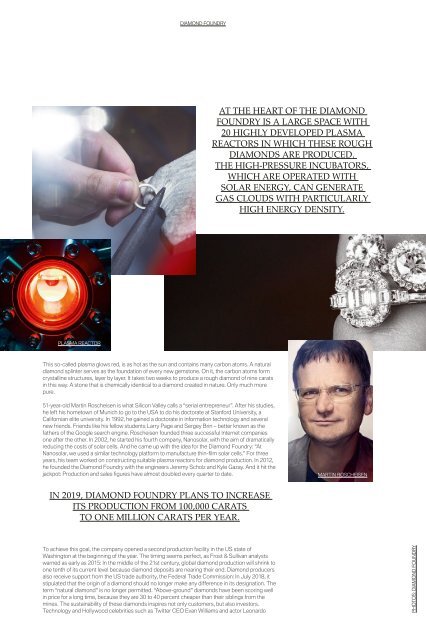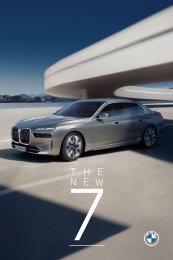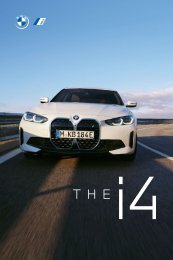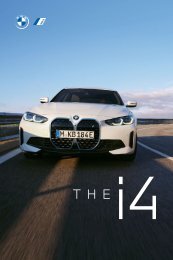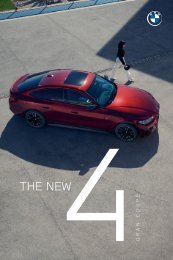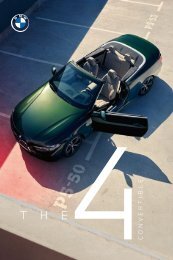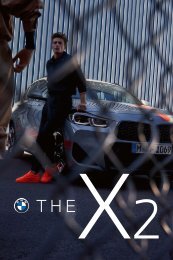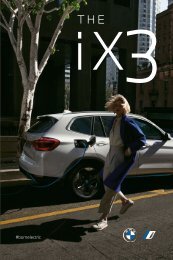BMW 8-serie Gran Coupé
You also want an ePaper? Increase the reach of your titles
YUMPU automatically turns print PDFs into web optimized ePapers that Google loves.
DIAMOND FOUNDRY<br />
DIAMOND FOUNDRY<br />
40<br />
41<br />
AT THE HEART OF THE DIAMOND<br />
FOUNDRY IS A LARGE SPACE WITH<br />
20 HIGHLY DEVELOPED PLASMA<br />
REACTORS IN WHICH THESE ROUGH<br />
DIAMONDS ARE PRODUCED.<br />
THE HIGH-PRESSURE INCUBATORS,<br />
WHICH ARE OPERATED WITH<br />
SOLAR ENERGY, CAN GENERATE<br />
GAS CLOUDS WITH PARTICULARLY<br />
HIGH ENERGY DENSITY.<br />
DiCaprio invested around 100 million US dollars in the company.<br />
“I‘m proud to invest in the Diamond Foundry,” says the lead actor in<br />
the Blood Diamond drama film. “This is where real diamonds are<br />
made in America – without the negative impact of diamond mines<br />
on people and the environment.” No wonder that a typical working<br />
day for Martin Roscheisen is no longer just behind a desk: “I spend<br />
time in our production and I support celebrities,” Roscheisen<br />
comments dryly. With success: For example, actress Patricia<br />
Arquette wore orchid earrings with 349 individual diamonds at the<br />
Golden Globes in January 2019 when she accepted her award on<br />
stage. Manufacturer of the earrings: the Diamond Foundry.<br />
The technology of the diamond producers from Silicon Valley also<br />
offers new possibilities for the design of gemstones. A unique<br />
piece of jewellery, which the Diamond Foundry produced<br />
according to a joint design by Apple‘s head of design Sir Jony Ive<br />
and the renowned industrial designer Marc Newson, is the (RED)<br />
Diamond Ring, which was auctioned at the beginning of December<br />
2018. The jewel reached a price of 461,250 US dollars.<br />
The special feature of this ring is that it was cut completely from<br />
one diamond and has about 3000 tiny facets. A rough diamond of<br />
this purity and size would not have existed in nature. Even the<br />
production in the plasma reactor was a challenge. Since there was<br />
no diamond splinter in the required dimension, the atoms had to be<br />
outwitted, so to speak. With a few tricks, the Diamond Foundry<br />
technologists mastered this hurdle so that at the end, a diamond<br />
block of the desired size could be created.<br />
Afterwards, everything had to be prepared for the grinding and<br />
polishing of this large-format stone – not an everyday task for the<br />
master cutter of the Diamond Foundry from Antwerp, who has<br />
DESIGN AND HIGHLIGHTS – EDITORIAL<br />
PLASMA REACTOR<br />
This so-called plasma glows red, is as hot as the sun and contains many carbon atoms. A natural<br />
diamond splinter serves as the foundation of every new gemstone. On it, the carbon atoms form<br />
crystalline structures, layer by layer. It takes two weeks to produce a rough diamond of nine carats<br />
in this way. A stone that is chemically identical to a diamond created in nature. Only much more<br />
pure.<br />
51-year-old Martin Roscheisen is what Silicon Valley calls a “serial entrepreneur”. After his studies,<br />
he left his hometown of Munich to go to the USA to do his doctorate at Stanford University, a<br />
Californian elite university. In 1992, he gained a doctorate in information technology and several<br />
new friends. Friends like his fellow students Larry Page and Sergey Brin – better known as the<br />
fathers of the Google search engine. Roscheisen founded three successful Internet companies<br />
one after the other. In 2002, he started his fourth company, Nanosolar, with the aim of dramatically<br />
reducing the costs of solar cells. And he came up with the idea for the Diamond Foundry: “At<br />
Nanosolar, we used a similar technology platform to manufacture thin-film solar cells.” For three<br />
years, his team worked on constructing suitable plasma reactors for diamond production. In 2012,<br />
he founded the Diamond Foundry with the engineers Jeremy Scholz and Kyle Gazay. And it hit the<br />
jackpot: Production and sales figures have almost doubled every quarter to date.<br />
MARTIN ROSCHEISEN<br />
IT IS THE<br />
CUT THAT<br />
GIVES THE<br />
DIAMOND<br />
ITS VALUE.<br />
already cut some of the world‘s largest diamonds. For this exclusive order, she had special tools<br />
manufactured by a diamond tool supplier in Belgium. In order to achieve maximum smoothness, the inner<br />
ring was cut out cylindrically with a micrometre-thin laser beam coated with water.<br />
It is the cut that gives the diamond its value. The highest level of precision is essential, not a fraction of a<br />
millimetre can be missed. Only then will the diamond reach its maximum radiant power. The Diamond<br />
Foundry is very proud of the high level of craftsmanship at which its polishers work and reliably achieve this<br />
goal. The brilliant cut, which is most in demand worldwide, is only one of 39 options. The cutters are able to<br />
bring diamonds into any individual shape.<br />
For Martin Roscheisen, there is hardly a wish that his master technologists and craftsmen cannot fulfil in the<br />
Diamond Foundry. Except one. Martin Roscheisen promptly answers the question of whether he is missing<br />
something from Germany: “Nuremberg grilled sausages! Bavaria should urgently work to export them all<br />
over the world.”<br />
IN 2019, DIAMOND FOUNDRY PLANS TO INCREASE<br />
ITS PRODUCTION FROM 100,000 CARATS<br />
TO ONE MILLION CARATS PER YEAR.<br />
To achieve this goal, the company opened a second production facility in the US state of<br />
Washington at the beginning of the year. The timing seems perfect, as Frost & Sullivan analysts<br />
warned as early as 2015: In the middle of the 21st century, global diamond production will shrink to<br />
one tenth of its current level because diamond deposits are nearing their end. Diamond producers<br />
also receive support from the US trade authority, the Federal Trade Commission: In July 2018, it<br />
stipulated that the origin of a diamond should no longer make any difference in its designation. The<br />
term “natural diamond” is no longer permitted. “Above-ground” diamonds have been scoring well<br />
in price for a long time, because they are 30 to 40 percent cheaper than their siblings from the<br />
mines. The sustainability of these diamonds inspires not only customers, but also investors.<br />
Technology and Hollywood celebrities such as Twitter CEO Evan Williams and actor Leonardo<br />
PHOTOS: DIAMOND FOUNDRY


